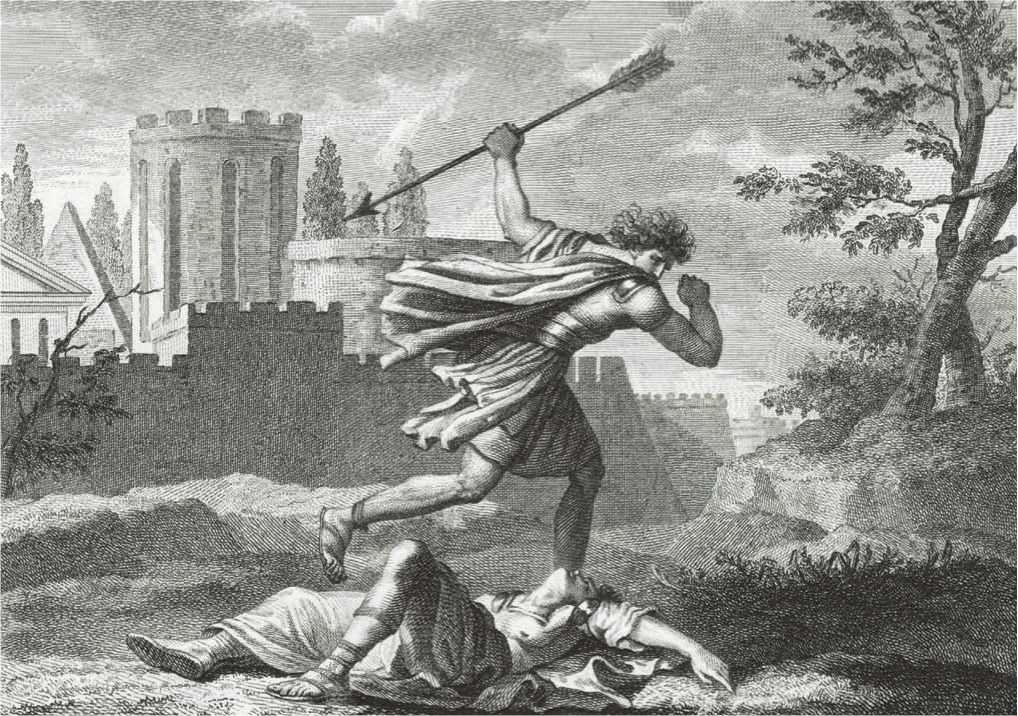Romulus wanted to found their new city on the Palatine Hill, while Remus favored another hill, the Remoria.
When Romulus and Remus put the question of which hill they should choose for their new city to Numitor, he advised them to leave that choice, as well as the decision as to which of the two would rule, to the gods. Numitor said that the twins would be able to discover the will of the gods through augury Augury was a way of interpreting divine will by observing the behavior of animals. Numitor told the twins that the gods’ decision would be revealed through the appearance of an unusual formation of birds—the twin who saw the birds first would be the one favored by the gods.
Romulus took up a position on the Palatine Hill, while Remus stood on the Remoria (see box). Romulus boastfully claimed to have seen the birds right away and sent messengers to summon Remus. In the meantime, Remus saw six vultures flying from the right. When Remus arrived on the Palatine, he asked Romulus about the birds he had seen. Romulus hesitated in answering; during this pause, 12 vultures suddenly appeared. Romulus then replied that what had happened some time before was not as important as the birds he could see for himself at that very moment. Remus had seen only six; Romulus, twelve. They argued over the fact that Remus had seen the vultures first but the larger number of birds had appeared to Romulus. Numitor ruled that the decisive factor was who saw the birds first. However, he ruled that Romulus’s initial sighting was the most important. The implication, in Dionysius’s
The Remoria
Scholars are divided about the exact location of the Remoria, the hill on which Remus stood while waiting for omens from the gods. Roman writer Sextus Pompeius Festus (second or third century CE) suggested that it was the Aventine Hill in Rome. However, this identification does not fit the evidence well. Dionysius of Halicarnassus said that the hill was "quite suitable for a city, not far from the Tiber, about 30 stades [5 miles or 8 km] from Rome." Some present-day scholars have suggested that the most likely location for the Remoria is in Magliana at the fifth milestone of the Via Campana, where the grove of the Roman fertility goddess Dea Dia stood. The sanctuary of the goddess was on the slopes of a hill now called the Colle delle Piche, "the Hill of Magpies." The hill stands close to the Tiber, about 5 miles from Rome, just as Dionysius described. Significantly, magpies were birds that often featured in auguries.
Below: The Founding of Rome by Romulus by Italian artist Giuseppe Cesari (c. 1568—1640). Romulus (right) oversees the digging of the ramparts.


Above: In this illustration Romulus stands over the body of his brother, Remus. In the best known version of the myth, Romulus killed Remus after he mocked Rome’s fortifications.
Account at least, is that Romulus won the contest through dishonesty, having summoned Remus before he had actually seen any birds at all.
There are various accounts of what happened next.
In one a fight broke out between the twins, with each supported by his own followers. Faustulus, in an attempt to end the battle, stepped between the two and was killed in the fray. Remus also perished. As a sign of remorse, Romulus buried him at his brother’s beloved Remoria before building the new city on the Palatine.
In another version of the story, Remus conceded the kingship to Romulus. However, when the foundations of Rome were laid, Remus mocked Romulus by leaping over the low wall, proclaiming that an enemy could overcome the new city’s defenses just as easily. According to Livy, Romulus then killed his brother in anger.
Other sources say that Remus was killed by a foreman named Celer, who was standing on the walls supervising the construction.
Whoever was responsible for Remus’s death, Romulus went on to become king of Rome. The city grew as fugitives from other cities came to live there. In order to procure wives for the many men living there, Romulus invited the Sabines, a neighboring tribe, to the city for a festival, and then captured their women.
Romulus ruled his people for 40 years, but then vanished mysteriously. While he was gathering his troops at the Campus Martius (Field of Mars), a thunderstorm blew up. Romulus was enveloped in a cloud and disappeared completely. His soldiers then hailed him as a god, believing that he had been taken up to heaven. Historically, Romulus was identified with the god Quirinus.
Daniel P. Harmon
Bibliography
Gardner, Jane F. Roman Myths. Austin, TX: University of Texas Press, 1993.
Scheid, John, and Janet Lloyd, trans. An Introduction to Roman Religion. Bloomington IN: Indiana University Press, 2003. Wi5eman, Timothy Peter. Remus: A Roman Myth. New York: Cambridge University Press, 1995.




 World History
World History









